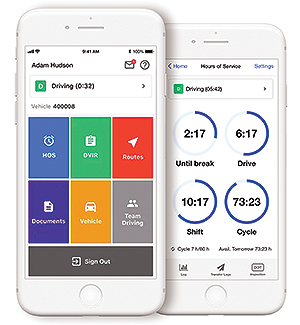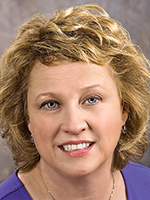ELD Vendors Update Software to Match Modified HOS Rules

[Stay on top of transportation news: Get TTNews in your inbox.]
Before the federal government’s revised hours-of-service rules went into effect Sept. 29, suppliers of electronic logging devices were busy updating their software to reflect those changes to the regulation that specifies commercial drivers’ permitted operating hours.
Beyond ensuring regulatory compliance, these software updates were designed to help motor carriers make the most of the greater flexibility afforded by the new ruleset, ELD vendors said.
James Victory, transportation compliance manager at oilfield equipment provider National Oilwell Varco, said the company’s ELD supplier helped it prepare for the regulatory changes.
“I think it went just about as smooth as you could expect, since there wasn’t any grace period in this regulation. They just went live with it on [Sept. 29],” Victory said. “This was an anomaly as far as regulations go, because they were less restrictive instead of more restrictive. So it wasn’t a big problem adapting to that.”

Flores
The Federal Motor Carrier Safety Administration formulated and implemented the HOS rule changes after receiving industry comments. Between the time FMCSA published the final rule May 14 and its Sept. 29 effective date, ELD vendors had to complete, validate and implement their software changes. Some began advance work in the spring or early summer.
“It was a tight timeline,” said Oswaldo Flores, safety and compliance product manager for Teletrac Navman, which provides its ELDs to National Oilwell Varco, among others.
“Fortunately for us and for the industry as a whole, there weren’t many changes” between the proposed and final rule, Flores said.
Under the new HOS rule, a 30-minute rest break is required after eight hours of drive time, rather than on-duty time; further, “on-duty, not driving” periods qualify as rest breaks. The revised rule also adds flexibility to the split sleeper berth exception by permitting drivers to divide their required 10 hours off duty into eight- and two-hour periods or seven- and three-hour periods. In adverse driving conditions, drivers now are allowed to extend the 11-hour driving limit and 14-hour driving window by up to two hours. The new rule also extends the maximum on-duty period and distance limit under the shorthaul exception available to certain local drivers.

Williams
Once the rule changes were announced, “our teams worked diligently to deliver software code that accounted for these changes,” said Glenn Williams, vice president of product management for Trimble Transportation.
Trimble’s software updates were made available to customers beginning in August, he said.
“Since any new rule like this can impact a driver’s workflow, we made a consistent effort to educate customers on what these changes entailed,” Williams added.
Trimble and other vendors said they delivered the majority of the software changes via over-the-air updates. Trimble also made new code available via USB stick for customers who preferred to update their devices manually.
The timing of the software updates was an important factor, vendors said.
“To ensure a smooth transition, the new rules were already in the latest version of the software and ready to be activated,” said Ray Sweeney, head of compliance products for Verizon Connect. “We had teams all over the world on standby at midnight to make sure that the switchover went smoothly and the software was working to the new rules.”

Fakkema
Fred Fakkema, vice president of safety and compliance for Zonar Systems, said the company’s over-the-air updates for its ELDs were designed to be user friendly. He likened the driver interaction to accepting an update on a cellphone.
Zonar also carefully considered the timing of the software update, including time zone differences.
“The time was 12:01 a.m. Eastern Standard Time, which was 9:01 here on the West Coast,” Fakkema said. “A lot of trucks aren’t moving at that time, so you can get the update done, and when the driver comes into work, the update is there once they log on.”
The “look” or screen presentation of their HOS software didn’t change dramatically, vendors said, and users might not even notice the minor changes to the software itself, Sweeney said. “The majority of the work is hidden beneath the surface in the rules engine that is constantly monitoring activity.”

Providers have updated their dashboards to allow better communication between managers and drivers. (Samsara)
At Samsara, the software changes included “updating our cloud dashboard so that fleet managers would be able to see what drivers’ logs looked like under the new rules,” said Sean McGee, director of product management.
For drivers, Samsara sent an over-the-air update “so when they logged in on Sept. 29, they would see their clocks reflect the new rules without them having to do anything,” he said.
Samsara started communicating with customers well before the September date via email and “banners”— updates in the product itself — announcing that the changes were coming, McGee said.
The company also provided FAQs and other documents to walk customers through the changes and held a webinar on the topic.
Preparing its software changes and achieving “readiness” took MiX Telematics seven weeks, including a testing cycle, said Jonathan Bates, its executive vice president of marketing.
Uploads to customers’ fleet vehicles were able to be done over the air, he said. When drivers restarted their vehicles, their ELD units booted up with the new software installed automatically, with the interface looking the same to drivers, he said.
ELD vendor Geotab created a separate ruleset within its Geotab Drive app for drivers who wish to use the more flexible split sleeper berth option.

Sutarik
“That was a big decision,” said Scott Sutarik, Geotab’s vice president of commercial vehicle solutions. “But we did that in order to maximize the drive time. ... We didn’t want to make assumptions on what the driver was looking to do. When a driver switches to the ruleset for the split sleeper berth, that serves to tell the system to calculate the driver’s hours accordingly.”
Drivers and administrative personnel also had to learn and master changes in the HOS rule and the ELD software. National Oilwell Varco sent messages to the ELDs, informing drivers of the changes.
“They all have our numbers so they call our admins if they have any questions,” Victory said.
Compliance coordinators at National Oilwell answer drivers’ questions about the regulations.
“They work hand-in-hand with the drivers every day,” Victory said. “They watch the ELDs, watch the data as it comes back from the field, let the drivers know if they’re using something the correct way or the wrong way.”
Bryce Wilson, a marketing manager with Teletrac Navman, said the vendor maintains a support line for drivers.
“If the drivers aren’t getting [needed] information and they’re not understanding how to use the software updates, they can call support agents [who] are specifically trained to help people on the road,” he said.

Crowley
Longtime vendors are likely to have become experienced at adjusting their software to stay current with regulatory changes.
“We’ve had other regulatory changes to HOS since our ELD solution launched, each with its own unique impact,” said Frances Yuronich Crowley, senior Encompass product manager for J.J. Keller & Associates.
Regarding the latest revisions to HOS rules, she said, “The changes provided more flexibility and productivity opportunities, so customers saw them as positive change.”

In this episode, host Michael Freeze takes a look at the surprising ways trucking companies are building strong, resilient cultures and attracting talent that stays. Hear a snippet, above, and get the full program by going to RoadSigns.TTNews.com.
ELD vendors also took steps to clarify details in the modified HOS regulations.
“The verbiage that FMCSA used in [the rule] confused some folks. It wasn’t clarified until FMCSA talked about it in their webinars and in their FAQs,” said Zonar’s Fakkema, who cited the 30-minute break as an example.
“It’s not required to be taken until [completion of] eight continuous hours of driving,” he continued. “When you think about ‘continuous,’ most people look at that as ‘always driving,’ and it’s not. It’s just eight hours of driving [before] you have to take a break. ... [Confusions of that kind] delay your development process because you’ve got to make sure that you get it right.”
Want more news? Listen to today's daily briefing:
Subscribe: Apple Podcasts | Spotify | Amazon Alexa | Google Assistant | More




